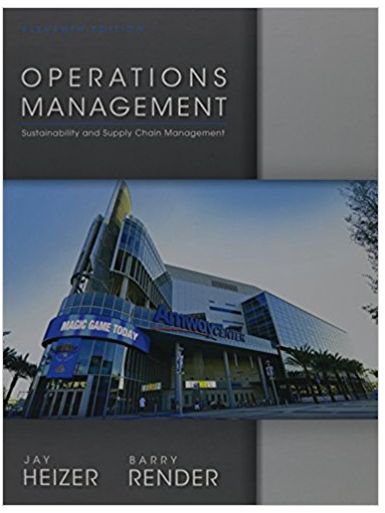Koontz Company manufactures two models of industrial componentsa Basic model and an Advanced Model. The company considers all of its manufacturing overhead costs to be
Koontz Company manufactures two models of industrial components—a Basic model and an Advanced Model. The company considers all of its manufacturing overhead costs to be fixed and it uses plantwide manufacturing overhead cost allocation based on direct labor-hours. Koontz’s controller prepared the segmented income statement that is shown below for the most recent year (he allocated selling and administrative expenses to products based on sales dollars):
| | Basic | | Advanced | | Total | ||
| Number of units produced and sold | | 20,000 | | | 10,000 | | 30,000 |
| | | | | | | | |
| Sales | $ | 3,000,000 | | $ | 2,000,000 | $ | 5,000,000 |
| Cost of goods sold | | 2,300,000 | | | 1,350,000 | | 3,650,000 |
| Gross margin | | 700,000 | | | 650,000 | | 1,350,000 |
| Selling and administrative expenses | | 720,000 | | | 480,000 | | 1,200,000 |
| Net operating income (loss) | $ | (20,000 | ) | $ | 170,000 | $ | 150,000 |
| | |||||||
Direct laborers are paid $20 per hour. Direct materials cost $40 per unit for the Basic model and $60 per unit for the Advanced model. Koontz is considering a change from plantwide overhead allocation to a departmental approach. The overhead costs in the company’s Molding Department would be allocated based on machine-hours and the overhead costs in its Assembly and Pack Department would be allocated based on direct labor-hours. To enable further analysis, the controller gathered the following information:
| | Molding | | Assemble and Pack | | Total | ||
| Manufacturing overhead costs | $ | 787,500 | | $ | 562,500 | $ | 1,350,000 |
| Direct labor hours: | | | | | | | |
| Basic | | 10,000 | | | 20,000 | | 30,000 |
| Advanced | | 5,000 | | | 10,000 | | 15,000 |
| Machine hours: | | | | | | | |
| Basic | | 12,000 | | | - | | 12,000 |
| Advanced | | 10,000 | | | - | | 10,000 |
| | |||||||
Required:
1. Using the plantwide approach:
a. Calculate the plantwide overhead rate.
b. Calculate the amount of overhead that would be assigned to each product.
2. Using a departmental approach:
a. Calculate the departmental overhead rates.
b. Calculate the total amount of overhead that would be assigned to each product.
c. Using your departmental overhead cost allocations, redo the controller’s segmented income statement (continue to allocate selling and administrative expenses based on sales dollars).
3. Koontz’s production manager has suggested using activity-based costing instead of either the plantwide or departmental approaches. To facilitate the necessary calculations, she assigned the company’s total manufacturing overhead cost to five activity cost pools as follows:
| Activity Cost Pool | Activity Measure | Manufacturing Overhead | ||
| Machining | Machine-hours in Molding | $ | 417,500 | |
| Assemble and pack | Direct labor hours in Assemble and Pack | | 282,500 | |
| Order processing | Number of customer orders | | 230,000 | |
| Setups | Setup hours | | 340,000 | |
| Other (unused capacity) | | | 80,000 | |
| | | $ | 1,350,000 | |
| | ||||
She also determined that the average order size for the Basic and Advanced models is 400 units and 50 units, respectively. The molding machines require a setup for each order. One setup hour is required for each customer order of the Basic model and three hours are required to setup for an order of the Advanced model.
The company pays a sales commissions of 5% for the Basic model and 10% for the Advanced model. Its traceable fixed advertising costs include $150,000 for the Basic model and $200,000 for the Advanced model. The remainder of the company’s selling and administrative costs are organization-sustaining in nature.
Using the additional information provided by the production manager, calculate:
a. An activity rate for each activity cost pool.
b. The total manufacturing overhead cost allocated to the Basic model and the Advanced model using the activity-based approach.
c. The total selling and administrative cost traced to the Basic model and the Advanced model using the activity-based approach.
4. Using your activity-based cost assignments from requirement 3, prepare a contribution format segmented income statement that is adapted from Exhibit 7-8. (Hint: Organize all of the company’s costs into three categories: variable expenses, traceable fixed expenses, and common fixed expenses.)
5. Using your contribution format segmented income statement from requirement 4, calculate the break-even point in dollar sales for the Advanced model.
Step by Step Solution
3.51 Rating (154 Votes )
There are 3 Steps involved in it
Step: 1
Only Requirement 1 ...
See step-by-step solutions with expert insights and AI powered tools for academic success
Step: 2

Step: 3

Ace Your Homework with AI
Get the answers you need in no time with our AI-driven, step-by-step assistance
Get Started


